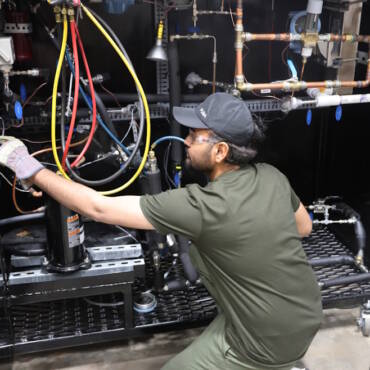Air conditioning maintains a comfortable environment inside the house during the scorching summer weather. However, it drives up the electricity bills. Right? Eco-friendly cooling equipment would be helpful to overcome this crisis.
Well! This article is going to highlight potential features that must be considered when purchasing an energy-efficient air conditioner.
1. Higher EER And SEER
Energy Efficiency Rating (EER) measures the unit’s cooling efficiency at a specific outdoor temperature. Seasonal Energy Efficiency Ratings (SEER) describe the total efficiency of an entire season.
Hence, higher EER and SEER ratings show greater energy efficiency measured in British Thermal Units or BTUs. BTUs vary according to the living space. The small area requires lower BTUs and large spaces demand higher BTUs. Obtaining an estimate of BTUs from an air conditioner service provider can be useful in this regard.
2. Energy Star Certifications
Units with blue energy star certification indicate less energy consumption in comparison to more standard models. That ultimately means a sharp reduction in bills. The energy star-certified products serve the consumer to save money without compromising on quality.
These certifications come with high CEER which permits considerable energy conservation. The Combined Energy Efficiency Rating (CEER) should be 10 for a large and 12 for a small air conditioner to meet the requirements for certification.
3. Energy Saving Setting
Another factor to look for in an energy-efficient AC is the energy-saving settings. This feature works using advanced technology. Once the desired temperature is achieved, the compressor and fan of the HVAC system are automatically turned off, which conserves the power with no manual effort.
For example, inverter units are more efficient than non-inverters. The logic behind the inverter functioning is variation in the compressor’s rotation according to load. Thus, it retains maximum power.
4. Programmatic Thermostat
A programmable thermostat allows homeowners to save electricity to some extent. This technological advancement decreases electricity payments, as studies have shown.
With this thermostat, you can program the desired settings for each day of the week, and the thermostat will operate automatically to adjust the temperature. With that being said, instead of running 24/7, the latest air conditioner only sustains heat inversions for lowering energy costs.
5. Right Size
The size of the cooling system matters a lot when it comes to power saving. Usually people want to install bigger units than necessary for their living area which creates a clammy environment. Others go with smaller ACs than their room size, which wastes electricity and costs them hugely.
If your room/office is small (100 – 300 square feet), you should go for an AC with a capacity of 5,000 – 6,500 BTU for better cooling and lowered energy costs. Quick Air experts, however, recommend that AC installation professionals should be consulted for determining the right size of AC for your room.
Final Verdict
Despite all the progress in technology, different air conditioners work distinctively for every user. This is because of the variability in the habits and requirements of people. Making use of the energy saving suggestions made in this article will certainly help you to reduce your electricity costs and cause you to be more thoughtful about how you use your HVAC unit.
Whether you require installation, repair, or maintenance, our technicians will assist you with top-quality service at any time of the day or night. Take comfort in knowing your indoor air quality is the best it can be with MOE heating & cooling services Ontario's solution for heating, air conditioning, and ventilation that’s cooler than the rest.
Contact us to schedule a visit. Our qualified team of technicians, are always ready to help you and guide you for heating and cooling issues. Weather you want to replace an old furnace or install a brand new air conditioner, we are here to help you. Our main office is at Kitchener but we can service most of Ontario's cities
Source link



Add Comment